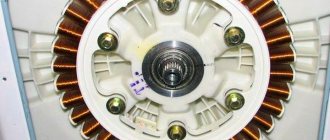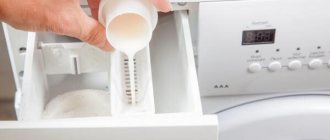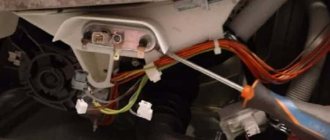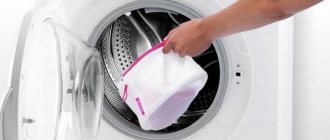The washing machine has become one of the main components of all household appliances, which is used in every home, regardless of income level. This is an indispensable assistant for housekeeping, but each technique has its own resource. Sooner or later we are faced with a moment when the washing machine does not spin out the clothes well. There are many reasons why equipment fails.
No spin
If you have to take completely wet laundry out of the machine, this does not always mean that it’s time to get upset and prepare for the costs of repairing the washing machine. Modern models are equipped with many automatic protection systems. Therefore, the case when the spin does not work may not be caused by physical breakdowns of the mechanics or electronics. This is often due to user errors or obvious violations of the device operating rules.
- The housewife loads an excessive amount of laundry into the machine. The loading volume of the model is always indicated in the instructions for its use. And if you load more into the drum, it will simply stop. This is standard protection that is present in modern models and prevents engine overload.
- An error was made when selecting the washing mode. For example, many washing machines have the option of so-called delicate processing of laundry or hand washing. In these cases, spinning is not provided or is performed at very low speeds. As a result, wet laundry has to be removed from the drum. There is only one piece of advice: you need to choose the right washing mode before starting the machine.
- If the washing machine is controlled by mechanical buttons, the lack of spinning may be due to the accidental pressing of the corresponding switch, which turns it off. The same situation occurs when the contact groups of the control panel are excessively dirty.
- There are too few things in the drum. In this case, the sensors of modern models detect imbalance during rotation, and the machine stops spinning. This prevents damage to the mechanical parts of the drive and drum.
Rarely, a non-working spin cycle is associated with a broken pump. In this case, the machine runs the cycle normally. But due to the lack of water pumping, the laundry remains wet. However, this situation is very rare. Modern machines detect a pump malfunction, display errors or refuse to start the wash cycle.
Design features of the automatic machine
All washing machines have a body that includes back and front panels, a lid and a bottom. Any device has a hatch. The most popular and in demand are front-facing models, in which the door is located on the front of the panel. Less common are products with a top hatch.
On the front of the case there is a control panel with a display and buttons. With its help you can switch programs and select the operating mode.
Next to the panel there is a tray for loading powder and conditioner (also called a powder receiver). The bottom of the hull is equipped with a technical hatch with a garbage filter and an emergency hose. The automatic machine also has a cord for operation from a 220 V network and 2 hoses.
The internal structure of the equipment is much more complex. It includes electronics (sensors, wiring), complex mechanisms, gaskets. Let's look at the main elements of an automatic machine.
- Electronic board. This is the “brain” of the device, coordinating the functioning of the washing unit.
- Inlet valve. Visually it is a plastic box with 1 or 2 coils. When voltage is applied, the membrane opens, due to which water is drawn into the drum.
- Motor. Recently, LG has been releasing models equipped with a direct drive motor. Such motors do not have a belt drive. Older models have commutator motors - they have a belt that stretches during intensive use and often falls off or breaks.
- heating element. With the help of this element, the water in the tank is heated to the set temperature provided by the program.
- Pump or pump designed to pump water out of a tank.
- Shock-absorbing elements that reduce vibration levels when washing and spinning clothes.
The design of the washing machine includes various cuffs, hoses and pipes.
Regardless of the appearance of the models, automatic machines may not wring things out for the same reasons.
The machine stops during the spin process
Unlike the case described above, the machine freezing during the washing process is almost always associated with hardware problems. Stopping can occur both during periods of rotation of the drum with water and laundry, and during spinning. There are several standard reasons for this problem.
- The drum balancing sensor is broken. This component is installed in almost all modern washing machines. It determines the uniform placement of laundry along the walls of the drum. If the control system does not receive the appropriate signal from the sensor, the machine simply stops. For example, it does not start spinning or rotating the drum to prevent mechanical damage due to vibration.
- Worn or damaged shock absorber unit. They stop performing their functions correctly. As a result, vibrations occur when the machine operates. Control sensors that monitor them initiate engine shutdown. This protects both the mechanics of the machine and the electronic control system.
- The tachometer is broken. There are magnets installed on the drum of the machine in the drive area. Their movement is monitored by a tachometer. If it is broken, the washer's electronics cannot correctly set the motor operating mode. As a result, the protection stops the spin cycle or terminates the program execution.
- The pressure switch is broken. The unit controls the water level. If it is broken or does not produce reliable data, the machine is not able to work normally. It does not recognize cases when there is water left in the drum, and cannot set the operating modes of the pump. Typically, the electronics stop the device before the spin process begins.
Electronic malfunctions, even those caused by the accumulation of dirt, are also dangerous. As a result, the machine either freezes or does not perform its functions correctly.
Diagnostics
that there are problems with spinning :
- The washing program has ended, but the tank remains filled with water;
- after washing, wet items are removed from the drum;
- spinning is carried out every other time;
- the washing machine hums as if it is spinning, but nothing actually happens;
- The water drains very slowly.
To find out the exact reason for the lack of spin in the washing machine, it is necessary to carry out a number of manipulations:
- Carefully study the control panel. Check the type of wash installed. Select the correct mode.
- If the specified spin speed is not enough, set the required amount manually.
- Distribute items evenly throughout the drum. Imbalance is one of the reasons for the lack of spin. To check whether this is so, you need to open the hatch, remove excess items from the washing machine, distribute the rest of the laundry evenly throughout the drum and restart the washing process.
After errors in operating the washing machine have been eliminated, you can begin checking its internal structure.
The following elements are diagnosed:
- Drive belt . To diagnose, move the washing machine away from the wall, remove the back panel, opening access to the pulley with the drive belt. Use both hands to scroll the belt to the right and left. If such actions cause the belt to sag, it must be replaced.
- Drain pump . To begin with, disconnect the equipment from all communications, then drain the water, unscrew the drain filter (located at the bottom of the front panel), pull out the powder receptacle, and lay the washer on its side. At the bottom of the Indesit washing machine there is access to the drain pump. It is carefully dismantled, checked for blockages (cleaned if necessary) or mechanical damage (if any, the part requires replacement).
You can independently diagnose technical faults that block the spin process, provided you have minimal knowledge of the structure of the washing machine (otherwise, it is better to entrust the inspection and repair of the washing machine to professionals).
Bad spin
If the laundry is not wrung out well enough, it is recommended to seek qualified help. There are a number of standard reasons that service engineers eliminate.
- Clogged pipes and clogged filter. When dirt accumulates, water cannot be drained in the quantities provided for by the characteristics of the machine. It needs to be disassembled, cleaned or filters changed.
- The engine is faulty. In case of interturn short circuits and other non-critical failures, it continues to work. However, in spin mode, the motor cannot accelerate the drum to optimal speed. As a result, the laundry remains damp.
There are also problems in the control system. They are diagnosed quite simply. The machine freezes, does not start spinning, and cannot correctly execute the specified program.
Motor malfunction
Washing machines use electric motors with a commutator and graphite brushes, which wear out during operation. Due to a decrease in the contact area and burning of surfaces, the power of the motor decreases, which cannot spin the drum to the required rotation speed. An additional cause of problems can be interturn short circuits or winding breaks, which negatively affect the performance of the motor.
The motor is removed from the machine body and checked with a test device for breakdown and integrity of the stator windings. After disassembly, you can verify the functionality of the windings on the rotor and check the condition of the brushes and bearing supports. Damaged elements must be replaced; if the windings are burned out, a new motor is purchased.
What can you do before calling a specialist?
Users who are forced to remove wet laundry from washing machines can conduct partial and complete diagnostics of the device. Some problems can be resolved without contacting a service center. Simple checks are done first.
- The set washing mode is checked. If it does not provide spinning, you should choose another program or set the correct number of revolutions for the mode.
- Make sure that there is not an excessive amount of laundry loaded into the machine. If you can’t determine its mass by eye, you should pull out a part and try to start the wash again.
- Check if the drum is unbalanced when there is a small amount of laundry. If it has gathered into one compact pile, it is worth distributing the contents over the walls in an even layer.
If simple measures do not help, a full diagnosis is carried out, starting with simple causes. First, unscrew the drain hose from the back of the machine. The filters are checked, as well as the pipe. If necessary, cleaning is carried out and parts are reinstalled.
Checking the tachometer will require disassembling the machine. The knot must be tightly fixed. If necessary, tighten the fasteners. The condition of the wiring and contacts is also checked. Damaged lines are replaced with solid sections of cable, connections are soldered, and areas are cleaned.
If the brushes are worn out or the motor is damaged, the machine may not be able to spin properly. The motor is removed. The unit checks the installation of the tachometer and the condition of the brushes. If the latter are worn out, they are replaced. It is also worth ringing the coils and replacing the engine if a malfunction is detected. However, such work is only available to users with the appropriate level of knowledge.
How to clean the drain filter
I would like to say a few words about this, because your actions will depend on the specific model of the washing machine:
- In Indesit, the hatch is made of fragile plastic material, and it must be opened quite carefully;
- Samsung is distinguished by the presence of special latches that open with a simple screwdriver;
- The hatch in Lg will not give in to you easily - you must press the button intended for this;
- Ardo also has access to the filter element from the front, but from the front side of the housing.
Unscrewing each filter is done the same way, only on certain models there are screws in the form of clamps. It is recommended that you carefully inspect the cap before you try to unscrew it.
Having organized access to the filtering device, it must be thoroughly cleaned and installed in its place. After this, it is recommended to test the washer. It is quite possible that this was not the only problem.
When the machine needs to be repaired in a workshop
If the washing machine, after carrying out preventive measures and using different loading configurations, still does not spin clothes well, then the reasons may be serious, and the equipment should be repaired by a specialist. You should contact the workshop in the following cases.
- Software failure. The machine does not operate according to the set mode.
- Engine failure. The cause of the problem may be the belt and brushes. The technician will determine the specific problem after disassembling the washing machine body.
- The bearings are worn out and need to be replaced.
- The pump problem can be solved by installing a new one.
If the wash is not finished, the time on the display does not change
See if the drum rotates.
If the drum does not rotate
- Wait 20 minutes for the error to appear.
- After an error appears, find its explanation or contact support.
If the drum rotates
- Wait 10 minutes, the machine will straighten the laundry.
- If the washing continues, then everything is in order, the machine has straightened the laundry. If the wash does not continue or the error UE, UB or 4E appears on the display, then the machine was unable to straighten the laundry. In such cases, proceed as indicated in the article “UE, UB, E4 errors on a washing machine.”
Recommendations for servicing washing equipment
Why does a washing machine become unusable over time? This depends on many factors, and is often associated with improper operation. Before starting the equipment for the first time, it is important to read the instructions, useful tips, and characteristics of installed programs.
If an incorrect program mode for a certain type of fabric can affect the quality and appearance of clothing (change in color or shape), then an incorrectly loaded volume of laundry leads to failure of the equipment itself.
It would be a good idea to check before loading for the presence of foreign objects both in the laundry basket and pockets, and in the drum itself. This is especially true for those who have small children: there may be candy, chewing gum, and pennies in their pockets. All this leads to serious problems.
Washing detergents with a high content of abrasive substances can damage the water level sensor, which is very important when performing the spin function. Care and compliance with operating rules will extend the life of the washing machine.
Preventive actions
The machine needs to be cleaned after every wash. It's not difficult to do this:
- take out the powder container, rinse off the powder;
- wash the place where the container is fixed;
- Wipe the rubber lining dry to remove any detergent residue.
When the wash is finished, do not close the drum; the machine needs to dry. It is strictly forbidden to wash the machine with detergents, especially the drum.
See also:
- 7 best Gorenje washing machines according to customer reviews
- 7 best washing machines under 20,000 rubles according to customer reviews
- 8 best narrow washing machines according to customers
- 8 best BEKO washing machines according to customer reviews
- 10 best washing machines from Samsung











